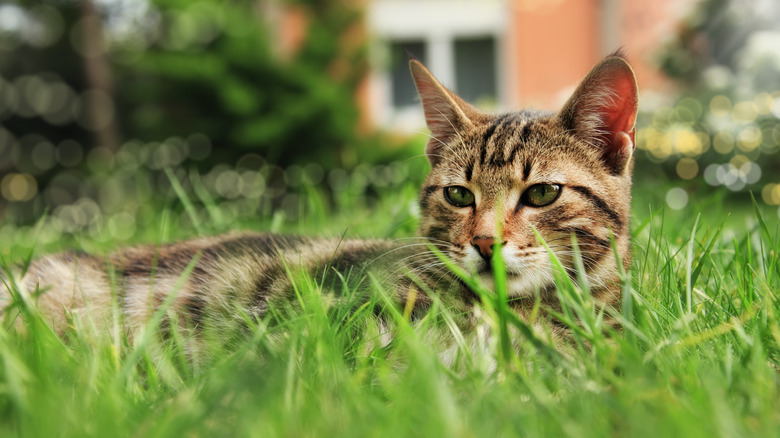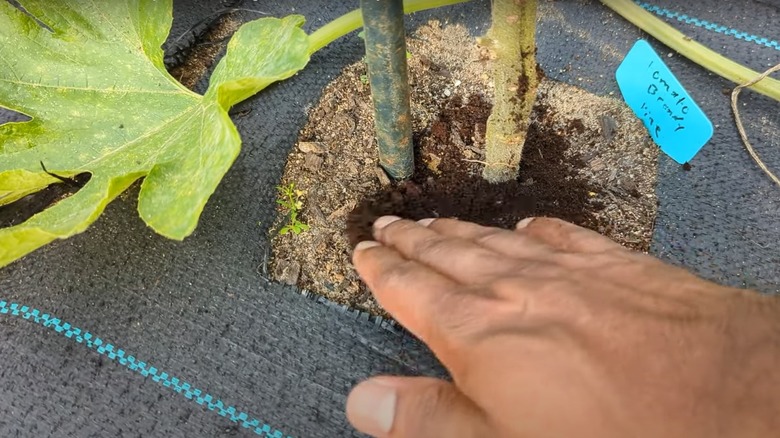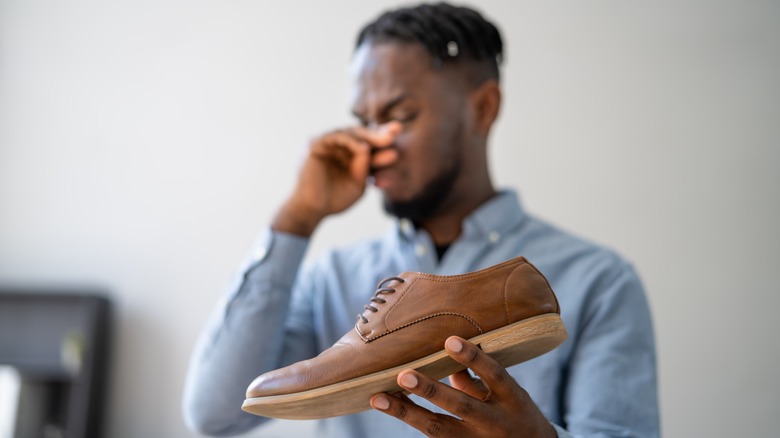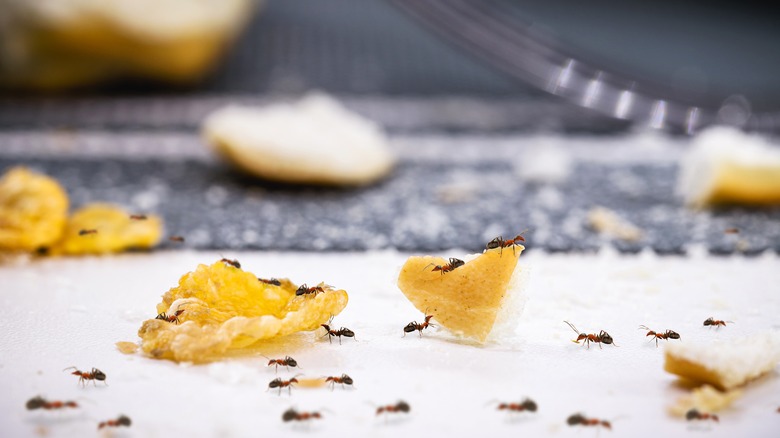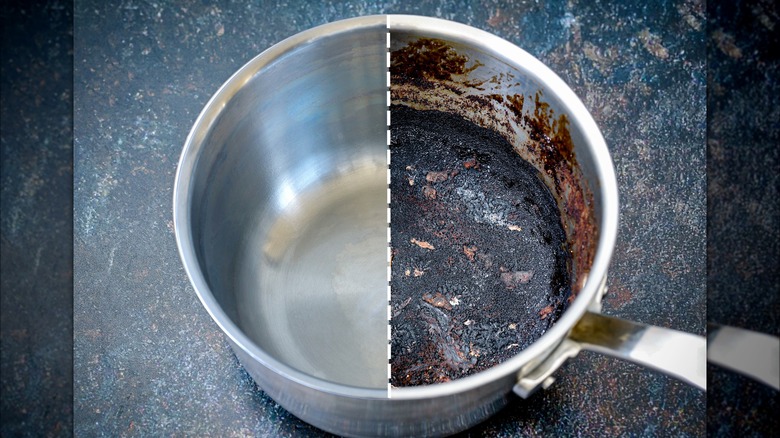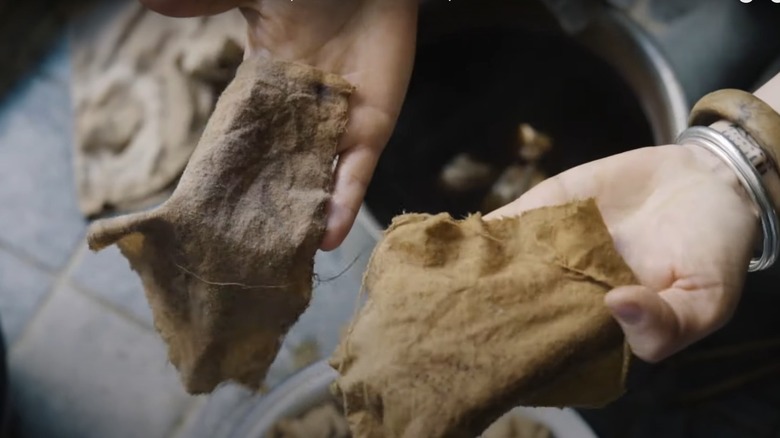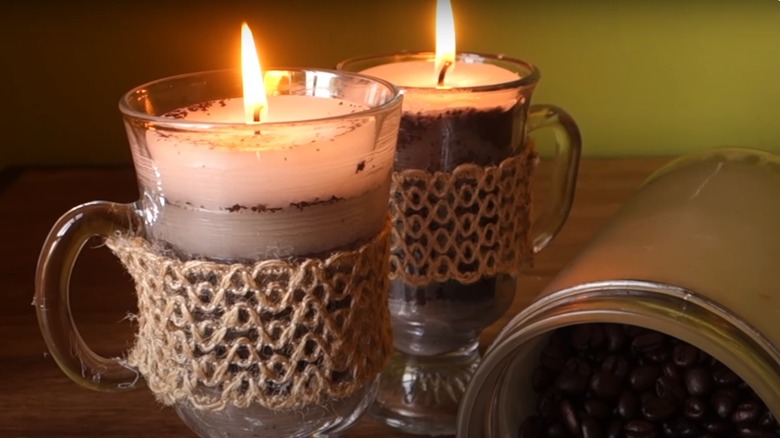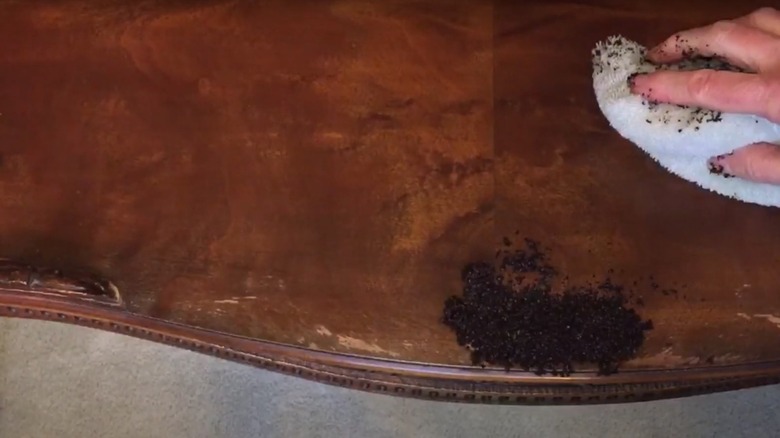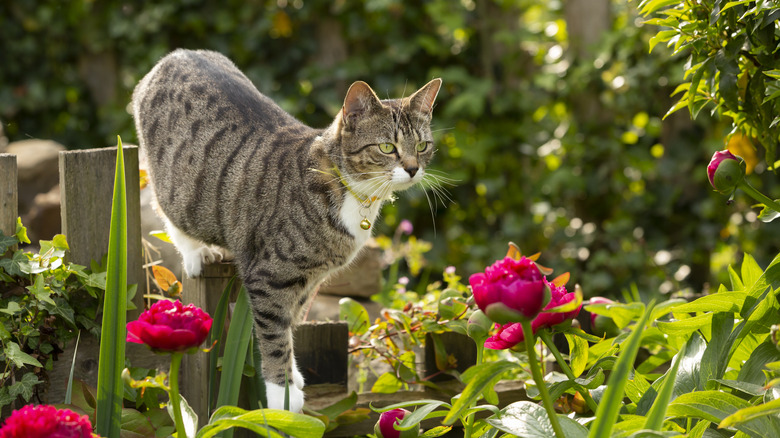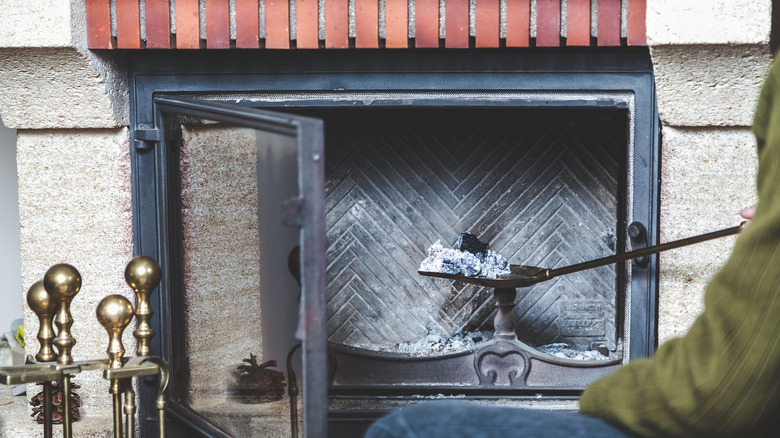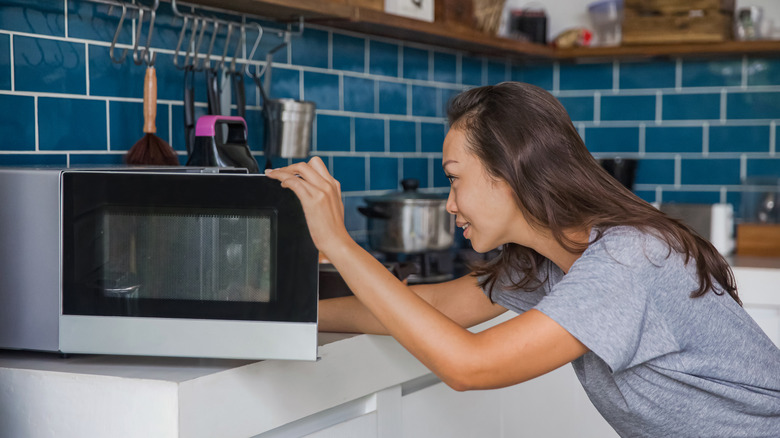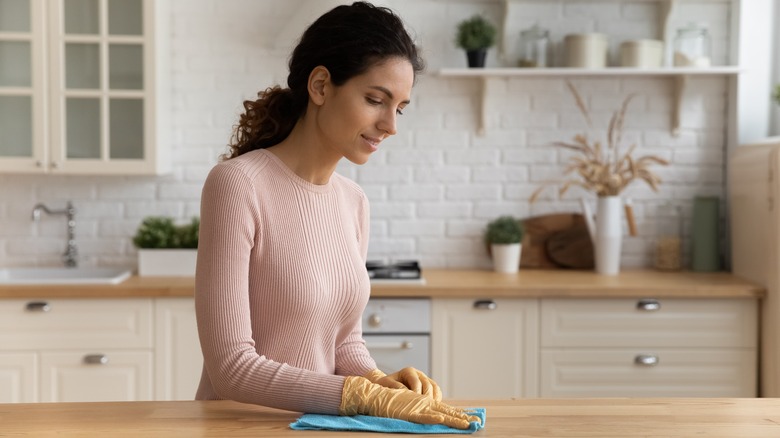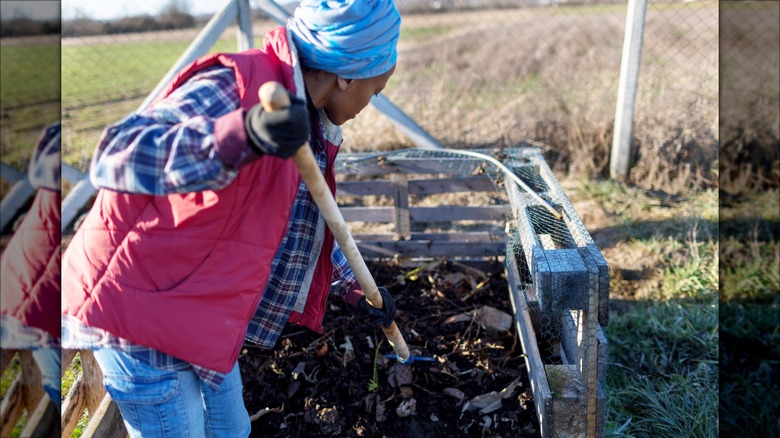Unexpected Uses For Leftover Coffee Grounds Around Your Home
If you're like many, no morning is complete (or even bearable, in some cases) without making a cup of hot coffee. Whether you grind your own espresso beans, rely on single-use pods, or purchase large canisters, you're left with wet grounds that likely end up in the trash can. However, when you simply toss the used dregs away, you're contributing to already overflowing landfills. The more trash that is thrown into our landfills, the more methane gas that is released.
Fortunately, there are ways that you can use your coffee grounds around the house to keep them out of the landfill. Not only are these ideas a more eco-friendly alternative to tossing more into your trash can, but you'll soon realize used java residue can actually come in very handy. Who would have guessed that they could help fertilize your plants, keep bugs away from the house, or even repair scratches on your wood furniture? Here are all the ways to utilize them.
Fertilize the garden
You know your morning cup of espresso helps to perk you up, but did you realize that the used grounds could also help the plants in your garden to grow? It turns out that they can work as a slow-release fertilizer, helping keep your plants healthy. The reason for this is that the sediment from your cup of Joe is actually a good source of nitrogen, an important mineral found in fertilizers. Moreover, they also contain phosphorus and potassium, other minerals that can support healthy plant growth.
If you want to take advantage of the fertilizing benefits of the used coffee, you'll find that they're easy to use. Simply spread the grounds in a thin layer around your plants. The nitrogen, potassium, phosphorus, and other beneficial nutrients will work their way into the soil and your plant's root system. As an added benefit, they will also help attract earthworms to the garden, further benefiting your plants.
Deodorize your shoes
If you've got a stinky shoe problem in the house, hold off on spending money on shoe deodorizing products. Instead, put your coffee dregs to good use and let them take care of the foul odors for you. They can work as a deodorizer to absorb the odors caused by sweat and bacteria.
However, pouring the coffee leftovers directly into your sneakers or heels isn't going to be a good idea, so you'll want to make a little sack to hold them. The material you choose for the sack should be permeable, allowing air to flow freely through it. Pantyhose is ideal for this solution. If you don't have any old pairs lying around in your drawers, buy a cheap pack and fill each "foot" section with about a cup or two of the coffee grounds. Tie the sacks off (and consider double "bagging" them to prevent leaks), and place them in the shoes overnight. Your boots and sneakers should smell much better the following morning.
Repel pests
To keep pests from invading your home and garden without using potentially toxic chemicals, look no further than the leftover "waste" in your coffee maker. As you already know, coffee is very aromatic. It's part of why many of us love it so much. But, it's also one of the reasons that bugs do not like it — they find its scent too strong and are repelled by it. You can even burn the espresso dregs to make them even more pungent and off-putting for insects and other pests.
Beyond not liking the aroma, the grounds can damage an insect's exoskeleton, eventually killing it. You can use the dregs to keep a wide array of pests away from your home. A few of these include ants, slugs, wasps, and snails. To put the leftovers from your morning brew to good use, use them to create a barrier around the entrances and foundation of your home, garden, or any other areas you wish to remain pest-free. Make the line you create at least two inches wide to ensure its effectiveness.
Clean the kitchen
Making your morning or afternoon cup of Joe isn't the only way to put coffee dregs to good use in the kitchen. They can also come in surprisingly handy for various cleaning-related tasks. One of these uses is for cleaning your pots and pans. If you've ever faced a burnt-on mess, you'll find that a few grounds can really come to the rescue. Because of their texture, they'll work as an abrasive to loosen the burnt- and stuck-on messes. To harness this cleaning power in each pan, combine the espresso sediment with a little warm and soapy water. Then, use your sponge to scrub the pan and work the coarse granules into the mess. Once done, thoroughly rinse out the pot.
Cleaning your oven is another chore in the kitchen that no one loves. Getting rid of those stains can seem like an impossible task. Fortunately, here is another way for you to harness the power of coffee sediment. Because of how acidic they are, the grounds can help break down and remove stubborn stains, leaving your oven nice and clean. Just put some on your sponge and use it to clean the inside of the appliance, using warm water to activate it. You can even soak the racks in a mixture of hot water and grounds for about an hour and then scrub the stains away.
Dye fabrics naturally
If you want to make some vintage-inspired clothing or linens, try using some grounds to help you achieve the look you're after. They work perfectly as a chemical-free dye for natural fabrics, such as wool and linen. Depending on the type of coffee you use or how strong it is brewed, it will turn your materials into varying shades of brown and tan. You can even use this as a hack to "rescue" that once-favorite white shirt with an espresso stain that won't come out. Embrace the stain and dye the whole shirt to match.
Before beginning, make sure that the fabric you're using is clean. New fabric should always be washed to make sure that any shrinking that is going to occur is taken care of before the dye is added. Place your grounds back into the coffee maker and brew another pot with them. Then, pour the brewed liquid over the (dampened) fabric in a large bowl or basin. Let the material soak to absorb the color. A shorter soak period will yield lighter colors. If you want a darker color, leave the fabric soaking for several hours.
Remove the fabric from the espresso liquid and wring it out. Then, soak it in a bowl of hot water and a little vinegar for about 10 minutes to set the dye. Finish up by rinsing the fabric, letting it air dry, and then ironing it to further set the dye.
Make your own candles
If you're a java lover, then chances are you love the way it smells. Why limit yourself to enjoying the pleasant aroma when you're brewing or sipping it? Enjoy this blissful smell anytime you desire by making an espresso-scented candle with the leftover grounds. This project can also help you repurpose the pieces of old wax candles that are otherwise unusable, making it even more eco-friendly.
In addition to the coffee grounds and recycled wax (or purchase soy wax flakes if you don't have any old candles lying around), you'll also need a candle wick, a mug or jar, a popsicle stick, and super glue. Begin by gluing the wick to the base of the mug. Once dry, loosely tie the upper end of the wick around the popsicle stick and place it across the cup. Melt the candle wax by putting it into a bowl or cup and putting it inside a pot of water on the stove. Slowly heat the water until the wax is melted, then remove it from the pot. Alternate pouring layers of wax and the coffee dregs into the cup until it is full. Once dry, trim the wick and enjoy your new, DIY-scented candle.
Repair scratches on wood furniture
Over time, you're likely to find more and more scratches on your wood furniture. However, you don't have to simply accept that it will always have this scratched and dinged-up appearance. You also don't have to spend a fortune hiring someone to restore the pieces. Instead, you can save money — and the appearance of your furniture — by using some coffee grounds. Because of their darker color, it'll be best to try this hack on wood furniture with darker coloring. You don't want to stain your lighter wood pieces, so always test an inconspicuous spot first.
All you'll need is wet, cooled dregs, a soft cloth, and a cotton swab. Once you have the materials prepared, cover the scratched areas with the damp sediment and let it sit for about 20 minutes. Then, wipe the crumbs off onto a plate or into a bowl, and look at the scratch. It should look more camouflaged than it did, but you may need to apply a second "coat" of the coffee for even better results.
Prevent cats from using your garden as a litterbox
Whether it is your feline friend or one that belongs to a neighbor, finding out that a cat has taken to using your garden as their personal litterbox can be frustrating, to say the least. Gardens often have a lot of open soil, making them an appealing outdoor litterbox for a cat. However, if you don't want kitties taking care of their business around your plants and flowers — and we're betting that you don't — use some coffee sediment to encourage them to find somewhere else to go.
Like many other animals, cats dislike the strong scent of java. Sprinkling the sediment around the garden will discourage the felines from stopping there to take care of their business. Either wet or dry grounds will work for this hack. The trick is that you'll have to recover your garden regularly. Otherwise, the grounds will lose their potency, and cats will start coming back.
Clean your fireplace
Keeping a fireplace clean can be a real challenge. The ash is dusty and difficult to remove without making even more of a mess — or irritating your breathing. Fortunately, coffee grounds can also help you clean your fireplace. Adding damp sediment to the dry ashes will make cleaning them easier.
Ash is very light, which is why it flies all around as you try to clean it out of the hearth. When you place the wet coffee dregs on top of it, they serve as a weight, preventing it from flying up and making a mess in your living room or getting inhaled through your nose. As winter turns into spring, and you're ready to give your fireplace a break during the warmer months, you can also use some of the dregs to help absorb lingering smoke orders. After cleaning the fireplace out, place some dry grounds along its base. Let them sit for several days to neutralize odors.
Deodorize the microwave
While a microwave can be a real lifesaver for many cooking needs, it can also get quite dirty. If food gets microwaved for too long, it may burn and leave behind a foul odor. Items can also slop or spill on the glass, creating new odors as these spills sit and get re-heated as you prepare other items. However, ground coffee will help you deodorize your microwave before the unpleasant smells take over your kitchen.
Add some of the grounds — approximately 2 tablespoons — into a bowl with ½ cup water. Heat the mixture in the microwave for about 2 ½ minutes, or until you begin to notice a fragrant coffee aroma. Carefully remove the bowl from the microwave (it will be very hot, and you don't want to spill the water). Immediately wipe out the inside of the appliance using a damp sponge or microfiber cloth to remove any remaining messes.
Clean sticky countertops
While using "dirty" coffee grounds for cleaning may seem counterintuitive, it is something you just might want to try. If you've ever run your fingers through the damp grounds, then you know that they have a gritty texture. It's that texture that can make them an asset for cleaning a variety of surfaces, especially countertops. Rubbing the grounds over greasy or sticky messes will help release the grime, and then you'll simply need to wipe everything away to be left with clean countertops.
If you want to give this method a try, sprinkle the used espresso grounds over your countertops. Dampen a sponge or a rag with some warm water, and use it to scrub the grounds over any sticky or grimy sections of your counter. Add a few more grounds and some more warm water as needed to help you to power through any messes that are left behind.
Enrich your compost pile
If you make a lot of coffee and just can't seem to find a way to use all the grounds, you still shouldn't just throw them away. Instead, add them to your backyard compost pile, or if you don't have one, find a community drop-off point. The higher nitrogen content of coffee grounds makes them an ideal addition to a compost pile. Without nitrogen, bacteria lack the energy needed to convert the other organic matter in the bin to compost.
Once the organic matter is broken down and you're ready to add the compost to your garden, the nitrogen will continue to offer benefits. It will help you grow healthy plants, particularly lettuce and other leafy greens. If you want to add coffee grounds to your compost pile, it is a simple task. Unlike some other additions that can add more work to keep up with the matter, the same is not true of grounds. Just toss them into the compost bin or pile, give everything a good mixing, and that's it. You're free to move on to another task, or relax — perhaps with a cup of Joe.
